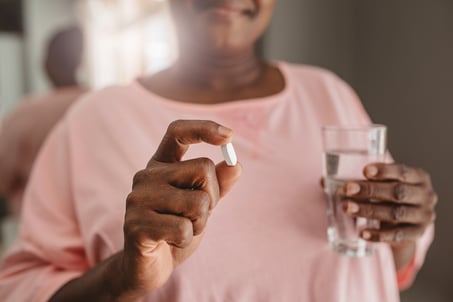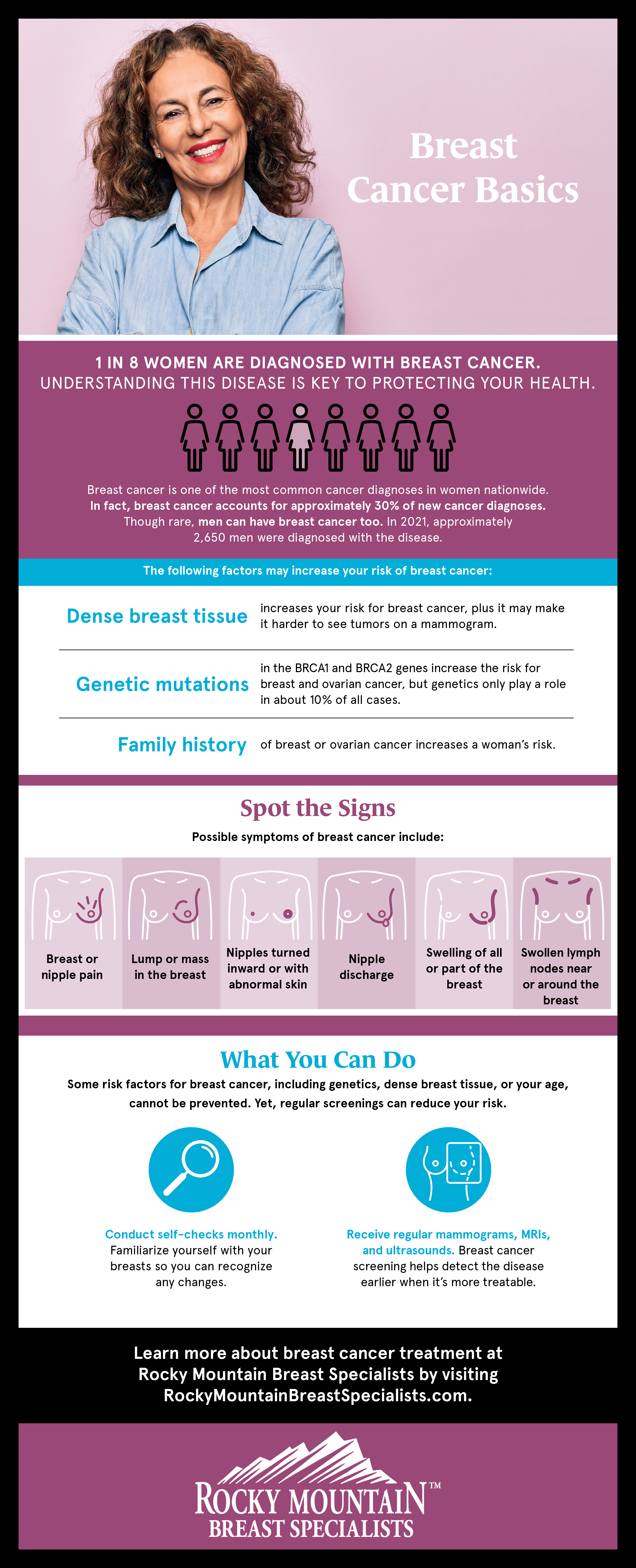How to Prevent Breast Cancer: What You Can and Can’t Control
6 min read

Women have a 1-in-8 chance of developing breast cancer at some point in their lives. In fact, breast cancer is one of the most common forms of cancer among American women. If you’re wondering how to prevent breast cancer, keep in mind that some risk factors are out of your control. You can lower other risks, however, by making certain lifestyle changes. If you are at an elevated risk of breast cancer, you can consult a doctor about medications or surgery.
Risk Factors for Breast Cancer You Can and Cannot Control
Many factors can contribute to the development of breast cancer. You can’t do anything about some risks, including those you’ve inherited from your family. Here are risk factors for breast you cannot control:
- Age and sex: While men can develop breast cancer, it is much more common in women, especially women older than 55.
- Dense breasts: You are more likely to develop cancer if you have dense breast tissue. Dense breasts also make it more difficult for radiologists to see signs of breast cancer on a mammogram.
- A family history of breast or ovarian cancer: While most women diagnosed with it do not have a family history of breast cancer, having a parent, sibling, or child who has had breast or ovarian cancer raises your risk for breast cancer.
- Genetic mutations: An inherited mutation in the BRCA1 or BRCA2 gene is the most common cause of hereditary breast cancer.
- Longer menstrual history: You are at a slightly higher risk of breast cancer if you started your periods early, especially before age 12, or began menopause after age 55. This may be due to having a longer lifetime exposure to estrogen and progesterone.
- Radiation therapy: If you have had radiation therapy to the chest for other cancers, you have a much higher chance of developing breast cancer.
- Other breast conditions: Certain benign breast conditions, such as atypical hyperplasia, can make it more likely to develop breast cancer.
Learn more about inherited breast cancer risks and other breast cancer risk factors.
However, other risk factors may be things you have control over, including:
 Physical activity level: Regular physical activity can reduce your risk, especially after menopause.
Physical activity level: Regular physical activity can reduce your risk, especially after menopause.- Weight: You are at a higher risk of developing breast cancer if you are overweight or obese after menopause. Talk to your primary care provider about ways you can reach a healthy weight to reduce your risk.
- Alcohol consumption: The more alcohol you drink, the higher your risk for breast cancer. The American Cancer Society recommends limiting alcohol to one drink a day for women.
- Menopausal hormone replacement therapy: Certain types of hormones taken to help relieve menopause symptoms have been linked to an increased risk of breast cancer. Combined hormone therapy, which is the use of both progesterone and estrogen, poses the greatest risk when taken for four years or longer.
- Birth control: Many forms of birth control use hormones, which can raise your risk for breast cancer. In particular, studies have found that taking birth control pills can put you at a slightly higher risk.
Other factors that may raise breast cancer risk include not having children or having a first child after age 30, smoking, not breastfeeding, and being exposed to certain cancer-causing chemicals.
Breast Cancer Prevention in High-Risk Patients
If you are at high risk of developing breast cancer due to a strong family history or inherited gene mutations, doctors may recommend taking steps to help prevent cancer from developing. These might include:
 Medication: Some women take a drug called tamoxifen for breast cancer prevention. Tamoxifen works by stopping estrogen from attaching to cancer cells and fueling their growth. High-risk post-menopausal women sometimes take another type of medication called aromatase inhibitors. This treatment lowers estrogen levels in women whose ovaries are no longer producing it. Both are more frequently used as part of a breast cancer treatment plan for certain types of breast cancer.
Medication: Some women take a drug called tamoxifen for breast cancer prevention. Tamoxifen works by stopping estrogen from attaching to cancer cells and fueling their growth. High-risk post-menopausal women sometimes take another type of medication called aromatase inhibitors. This treatment lowers estrogen levels in women whose ovaries are no longer producing it. Both are more frequently used as part of a breast cancer treatment plan for certain types of breast cancer.
You may also want to read: Can Tamoxifen Be Used to Reduce the Risk of Invasive Breast Cancer?- Surgery: Breast cancer prevention surgery is sometimes recommended for women at very high risk. A prophylactic mastectomy is a surgery to remove one or both breasts that can lower your risk by 90% or more. Some who have already been diagnosed with breast cancer may choose to also have the other breast removed when having surgery.
Your doctor will assess your overall risk for breast cancer to determine whether prevention methods, such as medication or surgery, might be right for you.
The Right Foods Can Help Prevent Breast Cancer
If you’re wondering about ways to prevent breast cancer naturally, you can start with the foods you eat. While no certain foods or single diet can cause or prevent breast cancer, studies suggest that following healthy eating patterns may lower your risk, as well as contribute to your overall well-being.
The following foods may help prevent the onset of breast cancer or slow the progression of the disease in people who have been diagnosed:
- A variety of fruits and vegetables, especially those that contain antioxidants, such as apples, blueberries, broccoli, carrots, lentils, peaches, and spinach
- Fish and poultry
- Foods rich in fiber, such as whole grains, beans, and legumes
- Foods that contain high amounts of vitamins, especially vitamin D
- Spices and vegetables with anti-inflammatory properties, such as clove, garlic, ginger, onion, pepper, and turmeric
The Mediterranean diet, which encourages eating whole grains, healthy oils, beans, nuts, seeds, vegetables, and fruit, may help prevent cancer. One study also revealed that eating a mainly plant-based diet could lower breast cancer risk by 15%.
The Importance of Mammograms
Regular breast cancer screenings can help improve breast cancer outcomes. This is because when breast cancer is detected early – the tumor is small and hasn’t yet had a chance to spread – it’s much easier to treat successfully. Using low-dose X-rays, mammograms give physicians a clear picture of breast tissue. They can often find small lumps and other abnormalities years before they might begin to cause symptoms. Studies have shown that women who have regular mammograms are less likely to need aggressive forms of treatment when cancer is detected and are more likely to be cured.
If you are at average risk for breast cancer, the American Cancer Society (ACS) recommends you follow these guidelines for which age to get mammograms:
- Women 40 to 44 have the option to begin getting yearly mammograms.
- Women 45 to 54 should have a mammogram every year.
- Women 55 and older can choose to continue yearly mammograms or switch to every other year.
The ACS recommends those at high risk of breast cancer get a mammogram as well as a breast MRI every year, usually starting at age 30.
Read more about breast cancer screening.
In Addition to Screening: Know the Symptoms of Breast Cancer
Recognize the symptoms of breast cancer so you know what to look for and when to see your doctor. Symptoms can include:
- Abnormal nipple or breast skin, including red, dry, flaky, or thickened skin
- Discharge from the nipple other than milk
- Nipple turned inward
- Pain in the breast or nipple
- Painless lump or mass
- Skin dimpling
- Swelling of all or part of a breast
- Swollen lymph nodes near or around the breast, often under the arm or near the collarbone
It’s helpful to familiarize yourself with how your breasts look and feel. Tell your doctor right away if you notice anything unusual.
At Rocky Mountain Breast Centers, our dedicated breast cancer specialists are here to help you through every stage of breast cancer treatment and beyond. Learn more about our multidisciplinary approach to breast cancer care and how we can help you.
